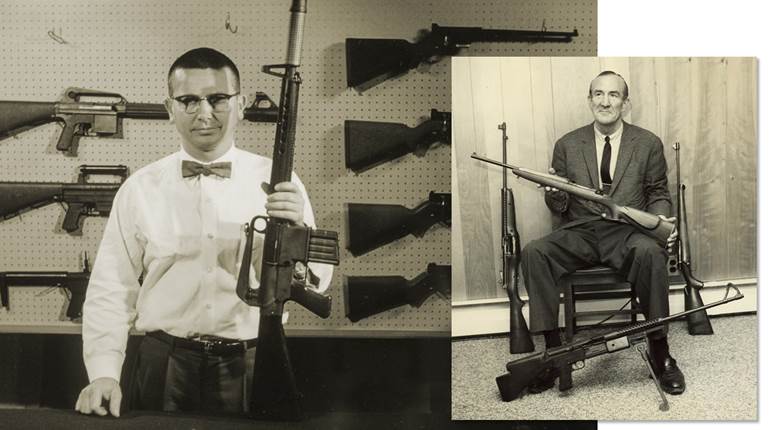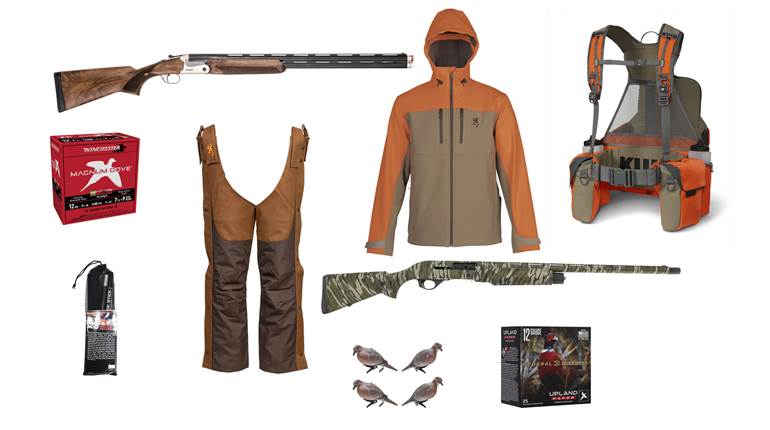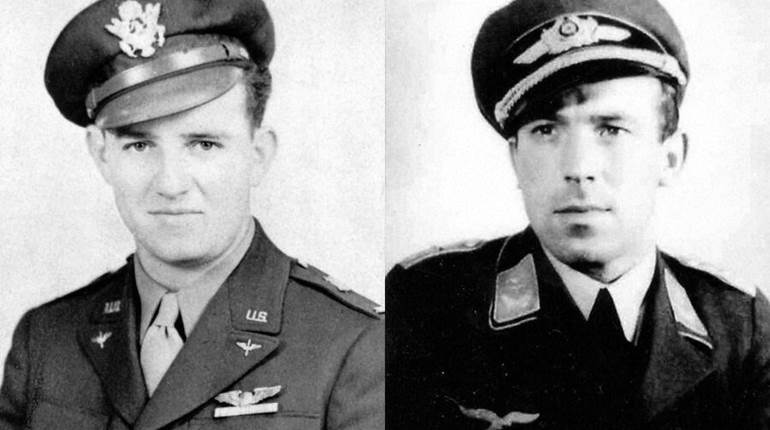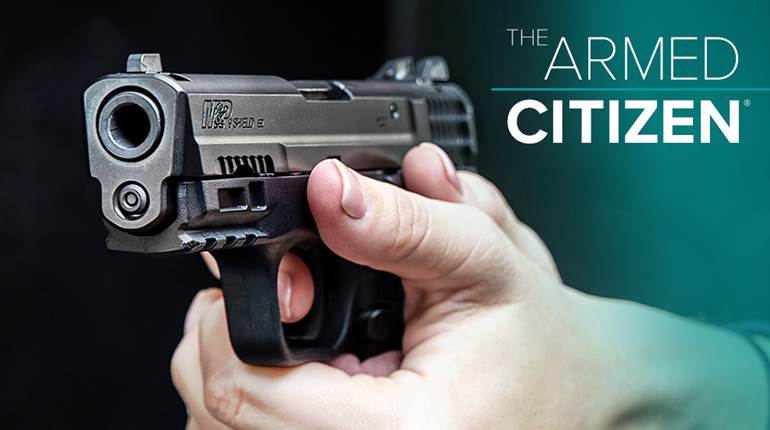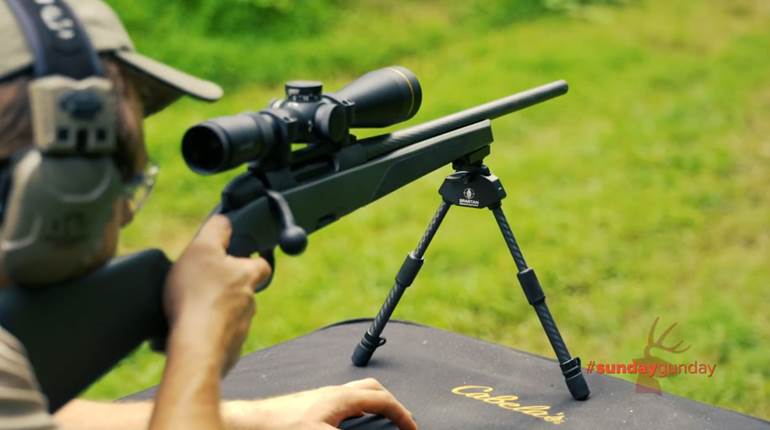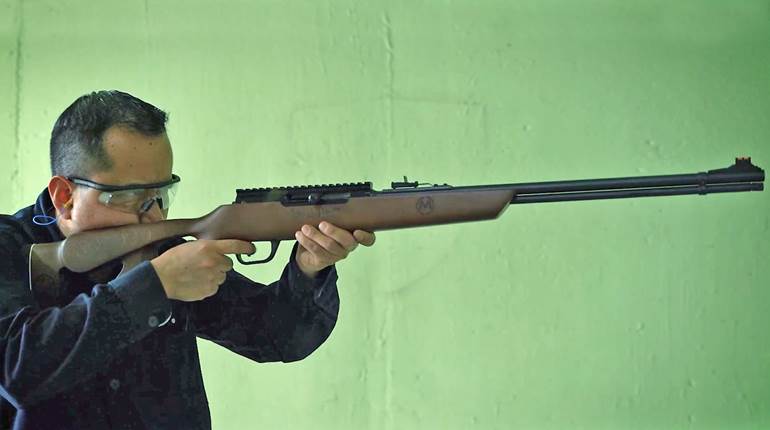
The Browning .30-cal. M1919A4 light machine gun was used to great effect in all theaters during World War II. A U.S. Army soldier (above) crews an M1919A4 during operations on Jan. 16, 1945, in northwest Europe.
During World War I, the water-cooled, belt-fed, tripod-mounted heavy machine gun proved to be one of the most ubiquitous and effective arms of the conflict. Most of the belligerent nations adopted such guns, and they were used with terrible effectiveness throughout the war. While capable of impressive sustained firepower, all shared the drawbacks of being cumbersome and heavy, which limited their use primarily to fixed defensive positions.
The standard United States heavy machine gun at the close of World War I was the .30-cal. Model of 1917, invented by the legendary firearm designer John Moses Browning. The Model 1917 performed as well as, or better than, any of the other comparable machine guns of the period; however, it also shared the same drawbacks. For example, it weighed almost 100 lbs. with a tripod and filled water jacket. As the war progressed, it soon became apparent that a Browning .30-cal. machine gun without the barrel water jacket, water can and heavy tripod could prove of value for use in aircraft and tanks, and also as a more flexible offensive infantry arm. However, the war ended before extensive development of an air-cooled variant of the Browning machine gun could be accomplished.
In 1919, the “Model of 1919” air-cooled .30-cal. Browning machine gun was adopted for use in tanks. A great deal of developmental work continued between 1919 and the mid-1930s on air-cooled Browning machine guns for use as infantry arms, including experimentation with various barrel lengths and different types of tripods. Such modified guns were much lighter and more portable than the M1917.
After evaluating all the various configurations, the U.S. Army Ordnance Committee recommended on Sept. 5, 1935, that a version of the standard M1919 air-cooled tank machine gun fitted with a 24" barrel with cooling slots, designated as the “Browning Machine Gun, Caliber .30, M1919A4,” be adopted as the standard light machine gun. A tripod that was lighter and more portable than the M1917 tripod was also adopted as the “Tripod, M2.” The M1919A4 machine gun with M2 tripod weighed about 48 lbs. and fired at a cyclical rate of about 450 rounds per minute. It could feed from a 250-round fabric belt or, later, metallic links.
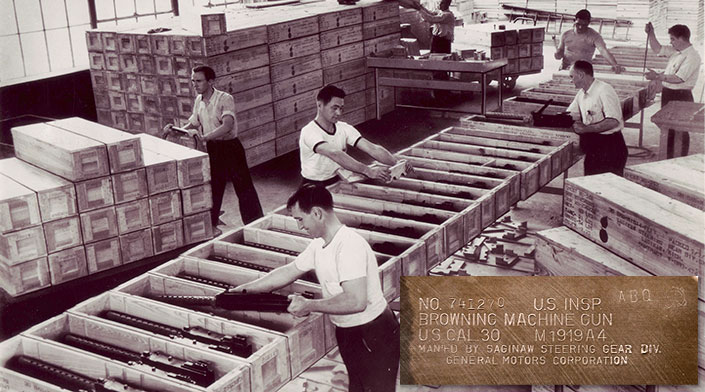
Prior to World War II, the M1919A4s were simply converted M1917A1s, having had the water jacket and related parts removed and a new barrel fitted (the M1917A1 was a slightly modified M1917). Once America entered the war, contracts were given to the Saginaw Steering Gear Division of General Motors and Buffalo Arms Co. for manufacture of the M1919A4. In addition to the M1919A4 tripod-mounted machine gun, a number of “M1919A5” machine guns were made for use in tanks. These were essentially the same as the M1919A4 but lacked a pistol grip, and the backplate was modified for mounting in armored vehicles. A bolt-retraction slide was also added. Of course, the M1919A5 was not used with a tripod. The M1919A4 was designated as a “flexible” machine gun, and the M1919A5 (along with the aircraft machine guns) was designated as “fixed.”
Saginaw made 350,951 M1919A4s from 1942 to 1945, while Buffalo Arms made 38,800 in 1942 and 1943. Due to Saginaw’s much lower production costs, the Buffalo Arms contract was canceled in July 1943.
Combat Use Of The M1919A4 Machine Gun
Despite not having the sustained firepower capability of the water-cooled M1917A1, the M1919A4 had other advantages. Of course, the most obvious was that the M1917A1’s weight and bulk limited it chiefly to fixed defensive positions while the M1919A4 was much lighter and, thus, much easier to move forward with rapidly advancing troops. It soon became one of the favorite arms of the World War II American infantryman. In testimony before an Army Ordnance committee meeting on Dec. 23, 1943, Marine Lt. Col. Victor Krulak had the following to say about the M1919A4: “It has come to my mind at the moment that I have done Mr. Browning a dreadful injustice in omitting one of the finest pieces of ordnance that has ever been designed, and that is the 1919A4 light machine gun, which we used to prodigious effect. It is the most dependable weapon that has ever come down the road. My only comments are those of humility. I am a member of the determined and belligerent school, which says, I repeat, which says we have no need for a water-cooled machine gun so long as we have that splendid weapon [1919A4] in our possession.”
Lieutenant Colonel Krulak was not one to mince words, and his effusive praise of the M1919A4 was ample evidence of the esteem he, and many others, held for the gun. Perhaps surprisingly, he also bluntly stated that the Marine Corps “had no need for a water-cooled machine gun,” even after the M1917A1 performed so well during brutal perimeter battles on Guadalcanal just a year earlier. Nevertheless, Krulak was not alone in his opinion that the air-cooled M1919A4 should replace the water-cooled M1917A1. Author and World War II Army Ordnance veteran Roy Dunlap related the following: “The 1919A4 Browning was the Army’s all-around .30 caliber machine gun. Air-cooled, heavy-barreled (took longer to heat up) and light enough to be moved and carried by one man, it was used as a co-axial arm in tanks … also in all sorts of vehicle mountings and its most important job, infantry machine gun. It was light enough to move up with any size unit and well enough engineered to serve as a medium machine gun if desired. In the latter reference, it almost replaced the water-cooled ‘heavy’ .30 machine gun, since it was a lot less bother and more dependable, even though it did not have the ability to sustain long bursts or stay in fire as long.”

Army Lt. Col. John George echoed some of the same sentiments as Dunlap and Krulak in his Shots Fired In Anger: “The only standard light .30 caliber machine guns which we used on Guadalcanal were those issued to the weapons platoons of our rifle companies. Our heavy weapons companies were still using the water-cooled Browning heavies, marvelous guns in the defense but very difficult to use in the jungle attack. Lights—even for the machine gun platoons—would have been better all-around guns for our purpose.
“Our Lights were used for many purposes all through the show. They made excellent trail-block weapons or fine main points upon which a rifle company commander could organize the rest of his fire in a defensive setup. Being handy and easy to carry, such guns could keep up with their companies or even large patrols … these guns were the first real firepower which a commander could rely upon during the early stages of a fight; the heavier guns and mortars, because of their weights, could seldom be counted on for sure until the second day or so.
“[I] believe this gun replaced the Heavy, to a large degree, in almost every Infantry regiment which fought the [Japanese]. It lacked the suitability of the Heavy for long-range and support (including overhead) fire because its mount was none too stable, but the Light was portable and it got there on time. And the same old basic Browning recoil-operated action gave it dependability to go along with its lead-slinging power. The LMG was a good gun with a very good record in the Pacific—half of World War II.”

These virtues of the M1919A4 were also highlighted in the combat report of the infantry arms used by the 3rd Marine Division during the Bougainville campaign: “LMG, cal. .30, M1919A4: The LMG is preferred to the heavier water-cooled gun in attack because of its mobility, low silhouette and the speed with which it can be placed in action. It was used extensively to reinforce rifle platoons sent out as combat patrols.”
The Ordnance Dept. publication “The Ordnance Department on Beachhead and Battlefront” cited the use of the air-cooled light machine gun in lieu of the water-cooled heavy during the Papua Campaign: “In heavy weapons companies the light .30-caliber machine guns replaced the more cumbersome heavies … .”
While the M1919A4 did not totally replace the M1917A1 in frontline service during World War II it did render the latter, more or less, a niche arm. The U.S. Marine Corps Tables of Organization & Equipment (TO&Es) for World War II reveal that many more M1919A4s than M1917A1s were authorized for a division as follows: 
Due to its lighter weight and portability, the M1919A4 machine gun was extremely valuable to units such as the Marine Raiders and Army paratroopers. Although the machine guns were dropped in equipment bundles separate from the paratroopers, it would have been difficult to use the M1917A1 and its weighty tripod and water can for airborne use. While boarding his C-47 transport plane departing for Normandy on the night before the D-Day invasion, paratrooper Chris Kanaras of the 101st Airborne Division noted that the pilots of the Troop Carrier Command were “getting upset about the amount of M1919A4 .30-cal. machine guns, demolition devices, boxes of ammunition, radios and rations.” If the pilots were upset about the weight of the M1919A4, they would have been apoplectic about transporting M1917A1s!
Once on the ground, the paratroopers made good use of the portability and firepower of the M1919A4. There was an incident during the Normandy campaign where its light weight was an invaluable asset. Paratrooper Ed Jeziorski was a machine gunner with the 507th Parachute Regiment of the 101st Airborne Division. As related in the book Down To Earth, “[J]eziorski … was running as fast as he could carry his Browning M1919A4 machine gun on his left shoulder and an ammunition can held in his right hand. His assistant gunner, Pvt. Grover O. Boyce, was directly behind him carrying the machine gun’s tripod. The wall of German fire was so intense … it sounded like a million mosquitoes in a confined space.
“[S]ince he was hefting the weight one of those M1919A4 machine guns, Ed Jeziorski had not been able to fire as he crossed the causeway. Instead, he and Pvt. Boyce had concentrated on getting to the other side as quickly as possible. Under Captain Rae’s direction, Jeziorski and Boyce kept moving and in seconds they came to a fork in the road. Jeziorski remembered what happened next: ‘As we came to that fork, 150 yards ahead of us was a MG42 on the left-side of the road and this guy opened up on us and when he did, Boyce dropped the tripod and we set up the gun on the road.’
“With Boyce providing cover fire with his rifle, Jeziorski dropped the pintle of the M1919A4 into the tripod, opened the weapon’s top cover, placed a cloth belt of .30-cal. ammunition into the feedway, closed the cover and racked the bolt. He then opened fire on the MG42 from right there in the middle of the road. In fact, one of Jeziorski’s bursts struck the German machine gunner right in the neck … .”
Jeziorski and his assistant gunner certainly couldn’t have handled a M1917A1 machine gun and tripod in the same manner, and the action illustrates the biggest advantage of the M1919A4; its light weight and portability.

There were also some instances when an American infantryman took a M1919A4 machine gun off the tripod and wielded it has a hand-held gun. One such soldier was Sgt. Thomas McCall of the Army’s 143rd Infantry when, after crossing the Rapido River in Italy, McCall was engaged in fierce combat action with his unit under heavy fire and taking many casualties: “McCall realized the German machine gun in front of him was preventing the men behind him from expanding the bridgehead … . Reaching down, he grabbed the .30-caliber machine gun (off its tripod), the ammo belt dangling on the frozen ground, and ran forward—directly toward the Nazi machine gun.
“The enemy gunners tried to cut McCall down, but in their shock and fear missed him. Seconds later, McCall stood over them, his legs spread wide. He opened fire. He didn’t miss. His raking fire killed the gun’s crew.
“A second enemy machine gun now fired on McCall from his left. The sergeant, moving as if his anger and frustration had hypnotized him, turned and charged this gun too. Still firing from the hip, he riddled the German crew and silenced that weapon.
“A third machine gun, fifty yards behind the second, next opened fire. When last seen, McCall was boldly walking toward that gun firing his weapon in short, measured bursts. He disappeared in the roar of an exploding artillery shell.”
Sergeant McCall’s brave actions resulted in him being posthumously awarded a Medal of Honor. The intrepid infantryman firing a belt-fed M1919A4 machine gun from the hip while knocking out several enemy machine guns was undoubtedly an inspiring sight.
Certainly, no gun is without faults, but the M1919A4 has one of the better reputations of any American military small arm used in World War II. The testimonies cited above are ample evidence of the high esteem in which the gun was held by the majority of its users. A report on the various arms used by a U.S. Marine Corps Raider Battalion on New Georgia Island perhaps sums up the prevailing feelings regarding the gun: “Browning Light Machine Gun, M1919A4. Experienced practically no stoppages, highly praised. Properly head-spaced, cleaned and cared for, the gun functions perfectly.”
The M1919A4 remained the U.S. military’s standardized light machine gun until 1957 when, like the M1917A1, it was officially superseded by the “all-purpose” M60 machine gun. Nonetheless, the M1919A4 continued to be used as a secondary arm well into the Vietnam War era. Once again, the genius of John Moses Browning was vividly displayed in the M1919A4 light machine gun.












